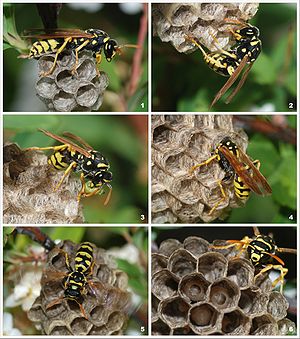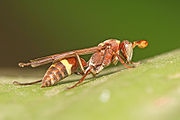
Paper wasp
Encyclopedia

Wasp
The term wasp is typically defined as any insect of the order Hymenoptera and suborder Apocrita that is neither a bee nor an ant. Almost every pest insect species has at least one wasp species that preys upon it or parasitizes it, making wasps critically important in natural control of their...
s that gather fiber
Fiber
Fiber is a class of materials that are continuous filaments or are in discrete elongated pieces, similar to lengths of thread.They are very important in the biology of both plants and animals, for holding tissues together....
s from dead wood
Wood
Wood is a hard, fibrous tissue found in many trees. It has been used for hundreds of thousands of years for both fuel and as a construction material. It is an organic material, a natural composite of cellulose fibers embedded in a matrix of lignin which resists compression...
and plant stem
Plant stem
A stem is one of two main structural axes of a vascular plant. The stem is normally divided into nodes and internodes, the nodes hold buds which grow into one or more leaves, inflorescence , conifer cones, roots, other stems etc. The internodes distance one node from another...
s, which they mix with saliva
Saliva
Saliva , referred to in various contexts as spit, spittle, drivel, drool, or slobber, is the watery substance produced in the mouths of humans and most other animals. Saliva is a component of oral fluid. In mammals, saliva is produced in and secreted from the three pairs of major salivary glands,...
, and use to construct water-resistant nests made of gray or brown papery material. Paper wasps are also sometimes called umbrella wasps, due to the distinctive design of their nests or other regional variants such as Trinidad & Tobago's use of Jack Spaniard.

Polistinae
The Polistinae are eusocial wasps closely related to the more familiar yellowjackets, but placed in their own subfamily, containing four tribes; with some 1100 species total, it is the second most diverse subfamily within Vespidae, and while most species are tropical or subtropical, they include...
, though it often colloquially includes members of the subfamilies Vespinae
Vespinae
The subfamily Vespinae contains the largest and best-known eusocial wasps, including true hornets , and the "yellowjackets" . The remaining genus, Provespa is a small, poorly-known group of nocturnal wasps from Southeast Asia. One genus, Palaeovespa, has been described from the Eocene fossil...
(hornet
Hornet
Hornets are the largest eusocial wasps; some species can reach up to in length. The true hornets make up the genus Vespa and are distinguished from other vespines by the width of the vertex , which is proportionally larger in Vespa and by the anteriorly rounded gasters .- Life cycle :In...
s and yellowjacket
Yellowjacket
Yellowjacket is the common name in North America for predatory wasps of the genera Vespula and Dolichovespula. Members of these genera are known simply as "wasps" in other English-speaking countries...
s) and Stenogastrinae
Stenogastrinae
The Stenogastrinae are a subfamily of Indomalayan and New Guinean Vespid wasps with a diverse biology from solitary to social.The subfamily contains 8 currently recognized genera....
, which also make nests out of paper. Twenty-two species of Polistes
Polistes
Wasps of the cosmopolitan genus Polistes are the most familiar of the polistine wasps, and are the most common type of paper wasp. It is also the single largest genus within the family Vespidae, with over 300 recognized species and subspecies...
paper wasps have been identified in North America
North America
North America is a continent wholly within the Northern Hemisphere and almost wholly within the Western Hemisphere. It is also considered a northern subcontinent of the Americas...
and approximately 300 species have been identified worldwide. The Old World
Old World
The Old World consists of those parts of the world known to classical antiquity and the European Middle Ages. It is used in the context of, and contrast with, the "New World" ....
tribe Ropalidiini
Ropalidiini
Ropalidiini is a tribe of social wasps inhabiting the Afrotropical, Indomalayan and Australasian biogeographical regions....
contains another 300 species, and the Neotropical tribes Epiponini
Epiponini
The Epiponini are a large and diverse tribe of social wasps mostly inhabiting the Neotropical region, with some species found also in the Nearctic region....
and Mischocyttarini
Mischocyttarus
Mischocyttarus is a very large, primarily Neotropical genus of social wasps with a few species found also in the Nearctic region. It is the only member of its own tribe, the Mischocyttarini....
each contain over 250 more, so the total number of true paper wasps worldwide is about 1100 species, nearly half of which can be found in the Neotropics.
The nests of most true paper wasps are characterized by having open combs with cells for brood rearing, and a petiole
Petiole (insect)
In entomology, the term petiole is most commonly used to refer to the constricted first metasomal segment of members of the Hymenopteran suborder Apocrita; it may be used to refer to other insects with similar body shapes, where the metasomal base is constricted...
, or constricted stalk, that anchors the nest (see image, right). Paper wasps secrete a chemical which repels ant
Ant
Ants are social insects of the family Formicidae and, along with the related wasps and bees, belong to the order Hymenoptera. Ants evolved from wasp-like ancestors in the mid-Cretaceous period between 110 and 130 million years ago and diversified after the rise of flowering plants. More than...
s, which they spread around the base of the anchor to prevent the loss of eggs or brood
Offspring
In biology, offspring is the product of reproduction, of a new organism produced by one or more parents.Collective offspring may be known as a brood or progeny in a more general way...
.
Most social wasp
Wasp
The term wasp is typically defined as any insect of the order Hymenoptera and suborder Apocrita that is neither a bee nor an ant. Almost every pest insect species has at least one wasp species that preys upon it or parasitizes it, making wasps critically important in natural control of their...
s of the family Vespidae make nests from paper; although some stenogastrine
Stenogastrinae
The Stenogastrinae are a subfamily of Indomalayan and New Guinean Vespid wasps with a diverse biology from solitary to social.The subfamily contains 8 currently recognized genera....
species, such as Liostenogaster flavolineata, use mud
Mud
Mud is a mixture of water and some combination of soil, silt, and clay. Ancient mud deposits harden over geological time to form sedimentary rock such as shale or mudstone . When geological deposits of mud are formed in estuaries the resultant layers are termed bay muds...
. A small group of eusocial
Eusociality
Eusociality is a term used for the highest level of social organization in a hierarchical classification....
crabronid
Crabronidae
Crabronidae is a large family of wasps, that includes nearly all of the species formerly comprising the now-defunct superfamily Sphecoidea. It collectively includes well over 200 genera, containing well over 9000 species. Crabronids were originally a part of Sphecidae, but the latter name is now...
wasps, of the genus Microstigmus (the only eusocial wasps outside the family Vespidae), also construct nests out of chewed plant fibers, though the nest consistency is quite different from those of true paper wasps, due to the absence of wood fibers, and the use of silk to bind the fibers.
Unlike yellowjacket
Yellowjacket
Yellowjacket is the common name in North America for predatory wasps of the genera Vespula and Dolichovespula. Members of these genera are known simply as "wasps" in other English-speaking countries...
s and hornet
Hornet
Hornets are the largest eusocial wasps; some species can reach up to in length. The true hornets make up the genus Vespa and are distinguished from other vespines by the width of the vertex , which is proportionally larger in Vespa and by the anteriorly rounded gasters .- Life cycle :In...
s, which can be very aggressive, polistine
Polistinae
The Polistinae are eusocial wasps closely related to the more familiar yellowjackets, but placed in their own subfamily, containing four tribes; with some 1100 species total, it is the second most diverse subfamily within Vespidae, and while most species are tropical or subtropical, they include...
paper wasps will generally only attack if they themselves or their nest are threatened. Since their territoriality can lead to attacks on people, and because their stings are quite painful and can produce a potentially fatal anaphylactic
Anaphylaxis
Anaphylaxis is defined as "a serious allergic reaction that is rapid in onset and may cause death". It typically results in a number of symptoms including throat swelling, an itchy rash, and low blood pressure...
reaction in some individuals, nests in human-inhabited areas may present an unacceptable hazard.

Caterpillar
Caterpillars are the larval form of members of the order Lepidoptera . They are mostly herbivorous in food habit, although some species are insectivorous. Caterpillars are voracious feeders and many of them are considered to be pests in agriculture...
s, flies
Fly
True flies are insects of the order Diptera . They possess a pair of wings on the mesothorax and a pair of halteres, derived from the hind wings, on the metathorax...
, and beetle
Beetle
Coleoptera is an order of insects commonly called beetles. The word "coleoptera" is from the Greek , koleos, "sheath"; and , pteron, "wing", thus "sheathed wing". Coleoptera contains more species than any other order, constituting almost 25% of all known life-forms...
larva
Larva
A larva is a distinct juvenile form many animals undergo before metamorphosis into adults. Animals with indirect development such as insects, amphibians, or cnidarians typically have a larval phase of their life cycle...
e, and they are often considered to be beneficial by gardeners.
See also
- Biological pest controlBiological pest controlBiological control of pests in agriculture is a method of controlling pests that relies on predation, parasitism, herbivory, or other natural mechanisms...
- Schmidt Sting Pain IndexSchmidt Sting Pain IndexThe Schmidt Sting Pain Index is a pain scale rating the relative pain caused by different Hymenopteran stings. It is mainly the work of Justin O. Schmidt, an entomologist at the Carl Hayden Bee Research Center in Arizona...
- PolistesPolistesWasps of the cosmopolitan genus Polistes are the most familiar of the polistine wasps, and are the most common type of paper wasp. It is also the single largest genus within the family Vespidae, with over 300 recognized species and subspecies...
- PolistinaePolistinaeThe Polistinae are eusocial wasps closely related to the more familiar yellowjackets, but placed in their own subfamily, containing four tribes; with some 1100 species total, it is the second most diverse subfamily within Vespidae, and while most species are tropical or subtropical, they include...
- RopalidiiniRopalidiiniRopalidiini is a tribe of social wasps inhabiting the Afrotropical, Indomalayan and Australasian biogeographical regions....

